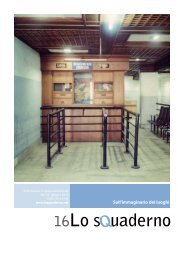La dematerializzazione contemporanea delle superfici
La dematerializzazione contemporanea delle superfici
La dematerializzazione contemporanea delle superfici
Create successful ePaper yourself
Turn your PDF publications into a flip-book with our unique Google optimized e-Paper software.
This is where resistance and its transformative capacity comes in. Situational interaction<br />
constantly modifies and reshapes the significance, impact and meaning of walls. Whereas,<br />
as said above, strategy aims at naturalising walls pushing them to the background, making<br />
them recede into invisibility, tactics constantly re-thematise walls, pulling them towards<br />
new social foregrounds. Tactics are enacted by actors who have no power on the governmental<br />
planning of space, but who nonetheless concur actively in the collective shaping of<br />
social territories. Walls are built by day and painted by night. Not simply do people live in<br />
Walls may introduced as strategical artifacts, but they are<br />
always subject to tactical uses. This is where resistance and<br />
its transformative capacity comes in. Situational interaction<br />
constantly modifies and reshapes the significance, impact and<br />
meaning of walls.<br />
walled environments, they make<br />
things with walls. Such uses of<br />
walls are material-and-semiotic just<br />
as walls themselves.<br />
Tactically speaking, the most<br />
remarkable fact about walls is that they offer a visible surface, which becomes a surface of<br />
inscription for stratified, criss-crossing and overlapping traces. Because of the very territorial<br />
nature of walls, such traces are highly visible interventions that define new forms of social<br />
interaction, even at a distance. Each wall creates a public, insofar as it defines a public focus<br />
of attention for a number of viewers and actors. Walls in urban environments are located<br />
at the convergence of a number of forces. Such convergence is precisely the domain of the<br />
public. Hence, walls often offer a playground to the struggle for public attention and the<br />
definition of visibility regimes, which ultimately are political regimes. Advertisement and<br />
graffiti are fully part of such process. But, in fact, even the density of people in a given space<br />
bounded by walls tactically interacts with the wall, as the case of crowds during demonstrations<br />
makes clear. In many cases, tactics play with minor fissures and interstices existing in<br />
every wall.<br />
From both the strategical and the tactical perspective, the wall is an object that constitutively<br />
calls into play the interweaving of space and social relations. Walls are inherently<br />
material and semiotic, material-and-immaterial. They manage space and define mobility<br />
fluxes that impose conduct and restrain freedom of movement, but they are also constantly<br />
challenged because of the symbolic meanings they assume: they can be reassuring as well<br />
as oppressive, they can be irritating as well as inspiring. Most interestingly, they can be built<br />
for an aim but deflected to many another.<br />
Il muro e la città<br />
I muri sono artefatti materiali progettati per promuovere date finalità. Nella maggior parte dei casi si tratta di<br />
finalità spaziali, come il recintamento e la separazione. In termini foucaultiani, i muri possono essere descritti<br />
come oggetti governamentali. Ciò significa che essi fanno parte di quella attività più ampia che è il governo<br />
della popolazione e, come si espresse Foucault (1978/1991: 95), ‘il governo non è una questione di imporre<br />
<strong>delle</strong> leggi agli uomini, ma piuttosto di disporre <strong>delle</strong> cose’. <strong>La</strong> governamentalità funziona definendo <strong>delle</strong><br />
posizioni in un campo relazionale di potere, che è essenzialmente di tipo territoriale (vedi lo Squaderno, no. 3).<br />
<strong>La</strong> governamentalità adotta perciò un punto di vista strategico sui processi sociali. <strong>La</strong> strategia mira a controllare<br />
References<br />
Michel Foucault (1978/1991) “Governmentality”, in Graham Burchell, Colin Gordon & Peter Miller, The Foucault<br />
Effect. Studies in Governmentality. London: Harvester Wheatsheaf.








